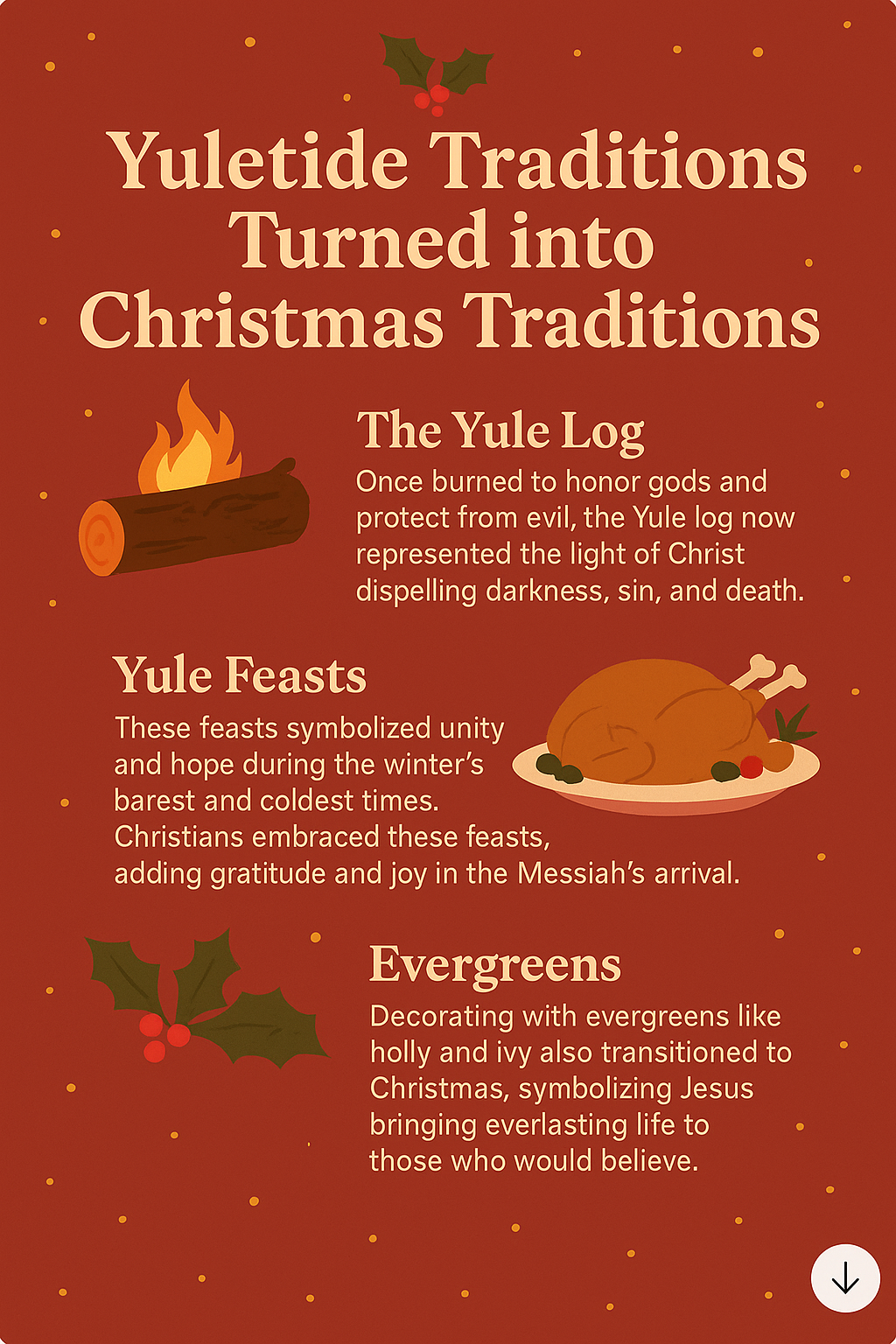We often hear the word Yuletide during the Christmas season, especially in older Christmas carols. We may be familiar with this word, but what does it actually mean?
Yuletide has roots in Scandinavian and Germanic traditions celebrating the winter solstice. Ancient Yule festivities marked this time with gatherings, feasts, and bonfires, celebrating new light and longer days. Traditions like the Yule log and evergreen decorations became essential symbols of hope and perseverance through the harsh winter. As Christianity spread, missionaries incorporated and adapted Yule customs into Christmas to help spread the Gospel. Yuletide traditions became intertwined with Christmas, communicating the joy of Jesus’ birth with symbols that already had importance for these communities.
Understanding the history of Yuletide gives us insight into the roots of some Christmas customs. As we celebrate, we should be mindful of the traditions we uphold, knowing where they come from and the meaning they carry. Rather than adopting new or old customs blindly, freedom in Christ calls us to use each action intentionally, even our decorations and meals, to remember Jesus and his work in our lives. Kingdom reality infuses every part of our lives, big and small. Paul tells us in 1 Corinthians 10:31, “So whether you eat or drink or whatever you do, do it all for the glory of God.” Through knowing the origins and adapting them to our faith, we can avoid celebrating in ignorance or even in ways that conflict with our beliefs, instead of glorifying God.
Let's explore more about the history of Yule and Yuletide and what it means for Christians celebrating Christmas today.
What Does Yuletide Mean?
“Yuletide” means “the time of Yule,” a period of winter celebrations in ancient Germanic and Scandinavian cultures. “Yule” comes from the Norse “jol,” a non-Christian festival celebrating the midwinter solstice. This tradition symbolized the return of light after the darkest days of the year, and honored things like rebirth, fertility, and the cycle of life. In the festival, usually around late December, families gathered for songs, feasting, and burning the Yule log, also a symbol of coming warmth and light.
Germanic tribes held various seasonal celebrations connected to nature, community, and their warrior culture. One key festival was Ostara, in the spring, marking the rebirth of life. During this celebration, people honored Eostre, the goddess of dawn and fertility, with feasts and dancing. Some customs involved practices that survive in modern Easter traditions. Mabon happened during the autumn equinox, when Germanic people gathered to give thanks for the harvest, honoring their abundant crops before the dark winter months. They shared in communal feasts and offered a portion of their harvest to their gods, showing respect for the seasons of life.
Germanic and Scandinavian tribes would go on raiding parties for the summer, and the Germanic warriors would celebrate Sigrblot in early April to prepare for the raiding season. Dedicated to Odin and other gods, Sigrblot included sacrifices and prayers for victory in battle. Warriors would share stories of courage, strengthening bonds within the tribe. Fortunately, Christianity never adopted this one, and neither has America.
These celebrations, including Yuletide, dominated the central and northern European tribes, marking the change of seasons and preparing for the future.
Origins of Yule in Norse and Germanic Cultures
Yuletide likely evolved gradually from smaller winter gatherings that celebrated seasonal shifts. Ancient peoples would pay attention to the skies and the seasons, even more as they developed agriculture, and the winter solstice could have been a general season of hope as they noted the gradual change from darker days to having more light. Over time, the observances probably grew into a more formal festival where communities celebrated and infused the time with meaning.
The winter solstice communicated great hope for survival. In a farming society in a colder climate, the people would need to store food to make it through the winter or face starvation and death. The solstice became a type of tipping point, telling people better days were ahead. They celebrated and honored the gods for their survival. Evidence suggests that Odin, known as the “Yule Father,” played a central role in Yuletide. He encapsulated the supernatural element of Yule with his ghostly and mythical “Wild Hunt.” As Yuletide developed, these traditions spread through the normal routes of trade, conquest, and migration until they became more uniform and adopted by the Norse and Germanic tribes.
Along with the feasts, drinking, and songs, ancient peoples would burn a large log to symbolize warmth and protection from the cold. People decorated the Yule log with holly, pinecones, and ribbons before lighting it. They thought the flames would chase away darkness and protect their home from evil spirits. Other traditions included placing evergreens like holly in homes. This symbolized life and hope.
Yule Traditions Adopted by Christmas Celebrations
Christianity spread into the Germanic areas of Europe through the Roman Empire first, and after its fall, the Holy Roman Empire rose and continued to spread Roman Catholicism through the next centuries. As Christianity spread and the Germanic tribes converted, some traditions became part of the new religion. The spring festival aligned well with Passover and the death and resurrection of Christ, which believers already celebrated, becoming what we know as Easter. The Catholics had already connected their winter celebration with Christmas, so the Germanic solstice festival easily connected with the birth of Jesus.

Yuletide and Christmas blended customs over time. Early Christian missionaries recognized the importance of Yule in the Germanic and Norse regions and incorporated Yule traditions to help locals understand the birth of Jesus.
- Since Yule already symbolized the return of light during the dark season, it naturally transitioned to the birth of Christ, who the Bible says is the “Light of the World” (John 8:12).
- The Yule Log, once burned to honor gods and protect from evil, now represented the light of Christ dispelling darkness, sin, and death.
- Large Yule meals symbolized unity and hope during the winter’s barest and coldest time. Christians embraced these feasts, adding gratitude and joy in the Messiah’s arrival. Sharing food and fellowship at Christmas became a way to connect with each other and honor Jesus.
- Decorating with evergreens like holly and ivy also transitioned to Christmas, symbolizing Jesus bringing everlasting life to those who would believe.
How Can Christians Reflect on Christ during Yuletide?
In the darkness of winter, Yuletide celebrates light breaking through, as Christ is the “light of the world.” Jesus brings us out of the “kingdom of darkness” and into his “glorious light.” (Colossians 1:13) His light isn’t temporary like the sun or seasonal like Yuletide. Instead, Jesus’ eternal light always guides and gives us a source of hope, as he promised to be with us always (Matthew 28:20).
The lighting of the Yule log resonates with the Holy Spirit as fire. In Acts, we read how tongues of fire descended on the disciples, filling them with the Spirit’s power and calling them into the community of the church. When we light the Yule log, we can remember the Spirit’s strength and ability to bring us in unity as the Church, sparking within us a holy fire which empowers us to serve and love as Christ did in a dark and corrupt world.
The holly’s sharp leaves and red berries remind us of Christ’s crown of thorns and his blood shed for our sin. Christmas celebrates Jesus’ birth, and his ultimate purpose: to die and rise again to give us eternal life. Evergreens also hearken back to the Tree of Life from Genesis, representing God’s promise. This Tree of Life reappears in Revelation in the midst of the new temple, where it continually provides life and healing (Revelation 22:2). Christ fulfills the Tree of Life by giving us access to God through his work.
Walking in Christ’s light means living in his grace, truth, and presence daily, not only during a single season. The apostle John reminds us, “If we walk in the light, as he is in the light, we have fellowship with one another” (1 John 1:7). God calls us to this deep connection with himself and others, the heart of Yuletide we can carry beyond the holiday season. In Christ, we have the promise of light in our lives and the strength to walk in that light, living out his love and truth all year.
Through Yuletide, we have an opportunity to use traditional symbols in redemptive and creative ways to deepen our relationship with Christ and declare him to others.
Peace.
Further Reading
Meaning of Christmas: Origins, History, and Traditions
What is Yule, and What Does it Have to do with Christianity?
What Does the Bible Say about Christmas Trees?
Photo credit: ©GettyImages/OlhaSydorenko/EyeEm


_639003522088907085.jpg)

